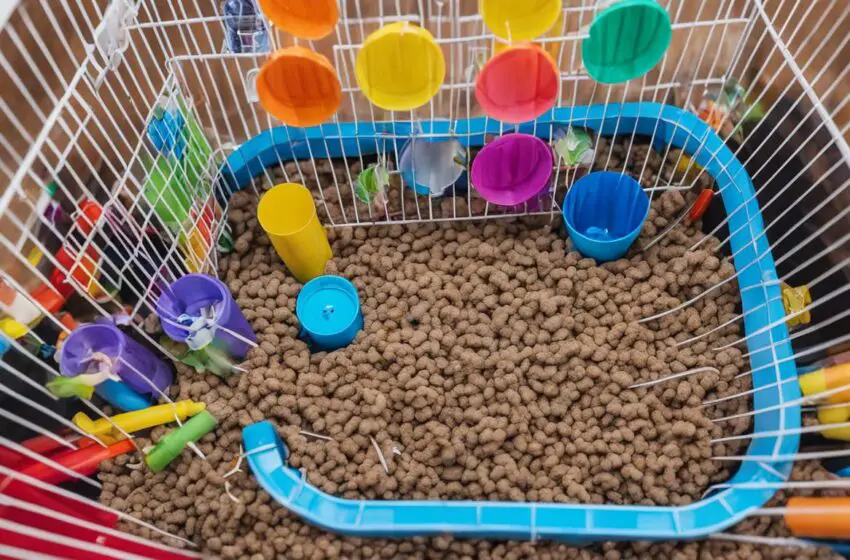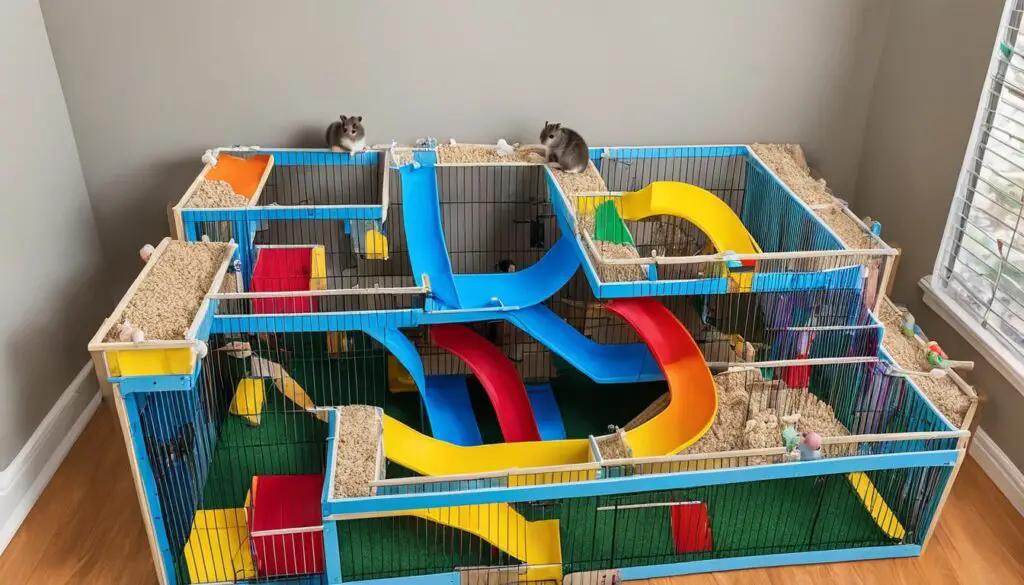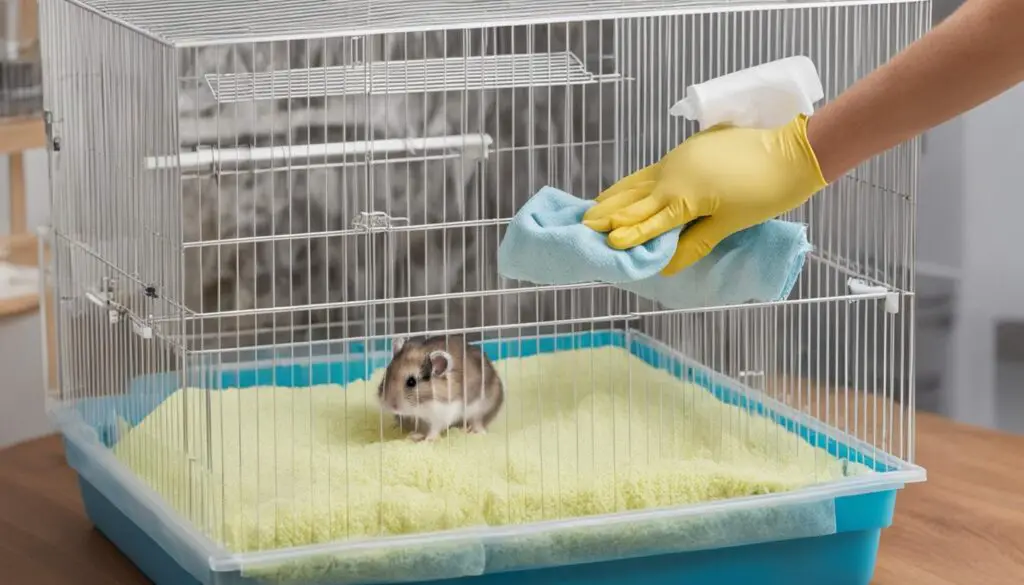How to Set Up the Perfect Hamster Cage

Setting up a hamster cage requires careful consideration to ensure the well-being and comfort of your furry friend. By following these essential tips, you can create an ideal habitat that will provide a happy and healthy environment for your hamster.
Key Takeaways
- Choosing the right cage is crucial for your hamster’s well-being.
- Include essential accessories like a hamster wheel and hideout.
- Use safe bedding materials to create a cozy environment for your hamster.
- Provide a balanced diet and fresh water for your hamster’s nutrition.
- Maintain a clean and hygienic cage for your hamster’s health.
Choosing the Right Cage
The first step in setting up the perfect hamster cage is to choose the right one. It’s essential to select a cage that provides ample space for your hamster to explore, exercise, and play. When it comes to cage size, it’s crucial to consider the needs of your specific type of hamster.
Determining the Ideal Cage Size
Different hamster breeds have varying requirements in terms of cage size. Dwarf hamsters, such as Roborovski or Campbell’s hamsters, can thrive in cages with dimensions of at least 24 inches by 12 inches. On the other hand, Syrian hamsters, also known as Teddy Bear or Golden hamsters, require a larger cage due to their larger size and increased activity levels. For Syrian hamsters, it’s recommended to choose a cage that is at least 30 inches by 15 inches.
Providing a cage with sufficient space is essential for the well-being and happiness of your hamster. It allows them to engage in natural behaviors like burrowing, running, and exploring their surroundings. A spacious cage also minimizes the risk of stress-related health issues.
Did You Know? A hamster can run up to 6 miles in a single night, highlighting the importance of ample space for exercise.
Additional Considerations
In addition to the size, certain features of the cage are important for your hamster’s comfort. Look for a cage with a solid bottom rather than wire flooring to provide a comfortable surface for your hamster’s feet. Wire floors can cause foot injuries and discomfort.
It’s also advisable to choose a cage with multiple levels or platforms, allowing your hamster to climb and explore different areas within the cage. This promotes physical and mental stimulation, preventing boredom and promoting overall well-being.
Remember, selecting the right cage for your hamster is the foundation for creating a safe and comfortable habitat. Once you’ve chosen the perfect cage, you can move on to selecting the essential accessories that will make your hamster’s environment even better.
Essential Cage Accessories
A well-equipped hamster cage is essential for providing a comfortable and stimulating environment for your furry friend. To ensure your hamster’s happiness and well-being, it is important to include the following accessories:
Hamster Wheel
A hamster wheel is a must-have accessory for your hamster’s cage. It provides them with the opportunity to exercise and stay active, which is crucial for their physical and mental health. A running wheel allows your hamster to burn off excess energy and maintain a healthy weight. Make sure to choose a wheel that is appropriately sized for your hamster to prevent any injuries.
Hamster Hideout
A hamster hideout is an essential accessory that provides your hamster with a sense of security and privacy. Hamsters naturally seek out small, enclosed spaces to rest and sleep. A hideout provides the perfect spot for your hamster to relax and feel safe. There are various types of hideouts available, such as small houses or tunnels, so you can choose the one that suits your hamster’s preferences.
Water Bottle and Food Dish
Easy access to fresh water and food is vital for your hamster’s health. Ensure that your hamster has a water bottle attached to their cage, providing a constant supply of clean water. A food dish is also necessary for serving their daily meals. Opt for durable and easy-to-clean dishes to ensure the hygiene of your hamster’s feeding area.
Tunnels and Toys
Adding tunnels and toys to your hamster’s cage can provide mental stimulation and enrichment. Hamsters are curious animals that enjoy exploring their surroundings. Tunnels provide a fun and interactive way for your hamster to navigate through their cage. Toys, such as chew toys and puzzle toys, keep your hamster entertained and prevent boredom. Rotate and introduce new toys regularly to keep your hamster engaged.

| Accessory | Benefits |
|---|---|
| Hamster Wheel | Provides exercise and promotes physical health |
| Hamster Hideout | Offers privacy and a sense of security |
| Water Bottle and Food Dish | Ensures easy access to essential necessities |
| Tunnels and Toys | Provides mental stimulation and prevents boredom |
Proper Bedding and Substrate
When it comes to creating a comfortable and safe habitat for your hamster, choosing the right bedding and substrate is crucial. The bedding material you select will not only impact your hamster’s comfort but also their respiratory health. Here are some tips to ensure that you provide the best bedding for your hamster.
Avoid Harmful Options
Pine and cedar shavings may be commonly available, but they are not suitable for hamster bedding. These types of wood shavings contain aromatic oils that can be harmful to your hamster’s respiratory system. Prolonged exposure may lead to respiratory issues and discomfort.
Safe Alternatives
Instead, consider using safe alternatives such as aspen shavings, paper bedding, or hemp bedding. These options are non-toxic and better for your hamster’s respiratory health. They provide a soft and comfortable surface for your hamster to burrow, nest, and play in.
Depth Matters
When setting up the bedding, ensure that it is at least a few inches deep. This depth allows your hamster to engage in natural behaviors like burrowing and nesting, providing them with a sense of security and comfort.
Remember, hamster bedding should be regularly cleaned and replaced to maintain a clean and healthy environment for your pet.
| Bedding Type | Pros | Cons |
|---|---|---|
| Aspen Shavings | – Soft and comfortable – Dust-free – Safe for hamsters | – Requires frequent changing – Can be messy |
| Paper Bedding | – Absorbent and odor-neutralizing – Easy to clean – Safe for hamsters | – May be less comfortable for burrowing – Can be more expensive |
| Hemp Bedding | – Biodegradable and eco-friendly – Soft and comfortable – Safe for hamsters | – May be less readily available – Can be more expensive |
Choose the bedding option that suits both your hamster’s needs and your preferences. Providing a safe and cozy bedding material will contribute to a happy and healthy life for your furry friend.
Nutritious Food and Fresh Water
When it comes to a hamster’s diet, providing the right food and fresh water is essential for their overall health and wellbeing. A balanced and nutritious diet ensures that your furry friend gets all the necessary nutrients to thrive. Here’s what you need to know:
- Commercially available hamster food: Choose a high-quality hamster food mix that contains a variety of seeds, grains, and pellets. These formulated diets are specifically designed to meet the nutritional needs of hamsters and provide a balanced combination of proteins, fats, and carbohydrates.
- Supplement with fresh vegetables and fruits: While hamster food mix forms the foundation of their diet, it’s important to supplement it with fresh vegetables and fruits. These provide additional vitamins, minerals, and fiber. Some safe options include carrots, broccoli, spinach, apples, and bananas. Remember to introduce new foods gradually and monitor your hamster’s response.
- Occasional treats: Treats can be given in moderation to add variety and excitement to your hamster’s diet. However, be cautious as some treats may be high in sugar or fat, which can lead to health problems. Stick to small portions of hamster-safe treats, such as dried fruits or specially formulated hamster treats.
- Fresh water: Just like humans, hamsters need access to fresh water at all times. Provide clean and fresh water in a secure water bottle attached to the cage. Regularly check the bottle to ensure it is not clogged and refill it as needed. This will help keep your hamster hydrated and prevent any health issues.
A healthy diet, combined with proper hydration, is crucial for your hamster’s overall well-being. It ensures their body functions optimally, promotes good digestion, and supports a strong immune system. Remember to consult with a veterinarian for specific dietary recommendations based on your hamster’s breed, age, and individual needs.
Remember, a well-fed hamster is a happy hamster!
| Food Group | Examples |
|---|---|
| Seeds | Sunflower seeds, pumpkin seeds, flaxseeds |
| Grains | Oats, barley, millet |
| Pellets | Hamster-specific pellets available in pet stores |
| Vegetables | Carrots, broccoli, spinach |
| Fruits | Apples, bananas, blueberries |
| Treats | Dried fruits, specially formulated hamster treats |
Providing a nutritious diet and access to fresh water will keep your hamster healthy, happy, and full of energy!
Comfortable and Enriching Environment
Creating a comfortable and enriching environment is essential for the well-being and happiness of your hamster. By providing the right elements in their cage, you can make sure your furry friend feels safe, secure, and stimulated. Here are some tips to help you create a hamster habitat that is both comfortable and enriching:
Add Soft Bedding
Soft bedding is not only cozy for your hamster but also provides them with a sense of security. Choose bedding materials such as shredded paper, aspen shavings, or hemp bedding, avoiding pine or cedar shavings that can harm their respiratory system. Make sure to have the bedding at least a few inches deep to allow your hamster to burrow and create nests.
Create Hiding Spots
Hamsters are natural burrowers and appreciate having hiding spots where they can retreat and feel safe. You can provide hiding spots by placing small tunnels, cardboard boxes, or hamster houses in the cage. These cozy hideaways mimic their natural habitat and give them a sense of security.
Include Toys and Chew Items
Hamsters have a natural instinct to gnaw and chew, which helps keep their teeth healthy and prevents boredom. Provide a variety of chew toys and items made from safe materials such as wood, sisal, or safe chewable plastics. This will not only satisfy their natural chewing instincts but also keep them mentally stimulated and entertained.
Rotate and Introduce New Items
To prevent your hamster from becoming bored, it’s important to regularly rotate their toys and introduce new items into their habitat. This helps keep their environment fresh and exciting, giving them new objects to explore and interact with. You can switch out toys every few weeks or introduce new ones to keep them engaged and curious.
By following these tips, you can create a comfortable and enriching environment for your hamster. Providing soft bedding, hiding spots, and a variety of toys and chew items will ensure that your furry friend has a stimulating and enjoyable habitat.
Regular Cleaning and Maintenance
Maintaining a clean and hygienic hamster cage is crucial to ensure your pet’s well-being. Regular cleaning and maintenance practices will not only keep the cage smelling fresh but also prevent the buildup of bacteria and other harmful contaminants. Follow these essential steps to keep your hamster’s habitat clean and healthy:
Spot-Cleaning Daily
Make it a habit to spot-clean the cage on a daily basis to remove any soiled bedding or waste. Use a small scoop or spoon to carefully remove the affected area without disturbing the rest of the cage. This helps prevent ammonia buildup and ensures a clean and odor-free environment for your hamster.
Thorough Weekly Cleaning
Perform a thorough cleaning of the entire cage at least once a week. This involves removing all the bedding, accessories, and toys from the cage. Dispose of the used bedding in a sealed bag and wash your hands thoroughly to maintain proper hygiene.
Next, clean the cage itself using a pet-safe disinfectant or a mild detergent. Scrub the cage gently, ensuring that all surfaces are thoroughly cleaned. Rinse the cage with clean water to remove any cleaning residue, and allow it to dry completely before adding fresh bedding and accessories.
Monitoring for Wear and Tear
Regularly check the cage for any signs of wear or damage. Inspect the bars, latches, and other components to ensure they are secure and in good condition. Replace any worn-out or broken accessories to prevent injury to your hamster and maintain a safe environment.
Recommended Cleaning Schedule
| Cleaning Task | Frequency |
| ————————- | ——————— |
| Spot-Cleaning | Daily |
| Thorough Cleaning | Once a week |
| Monitoring for Wear | Regularly |

By establishing a regular cleaning and maintenance routine, you will provide your hamster with a clean and healthy living space. Remember to prioritize cage hygiene for the overall well-being of your furry friend.
Conclusion
By implementing the recommended strategies for hamster cage setup, you can create an optimal living space that promotes the well-being and happiness of your pet. The right cage size, equipped with essential accessories like a hamster wheel and hideout, plays a crucial role in ensuring a healthy and stimulating environment. Selecting safe and suitable bedding materials, along with providing a balanced diet and fresh water, further contribute to your hamster’s overall well-being.
Creating a comfortable and enriching environment through the addition of soft bedding, hiding spots, and interactive toys helps to satisfy your hamster’s natural instincts and prevent boredom. Regular cleaning and maintenance routines ensure hygiene and extend the lifespan of the cage and its accessories. By following these guidelines, you can set up a hamster cage that promotes a happy and healthy life for your furry friend.
Your hamster’s welfare is of utmost importance, and providing an ideal cage setup is the first step towards ensuring their happiness and health. Remember to seek out reputable brands for supplies and consult with a veterinarian for any specific dietary or health concerns. With the right care and attention, you can create a nurturing environment that your hamster will thrive in for years to come.
FAQ
How do I choose the right cage for my hamster?
When choosing a cage for your hamster, make sure it provides ample space and comfort. Dwarf hamsters thrive in a cage size of at least 24 inches by 12 inches, while Syrian hamsters need a larger cage. Look for a cage with a solid bottom for your hamster’s comfort.
What accessories should I include in my hamster’s cage?
Essential accessories for your hamster’s cage include a hamster wheel for exercise, a hamster hideout for privacy and nesting, and a water bottle and food dish for easy access to necessities. Tunnels and toys can also provide mental stimulation for your hamster.
What type of bedding should I use for my hamster’s cage?
It is important to choose a safe and suitable bedding material for your hamster’s cage. Avoid pine or cedar shavings, as they can be harmful to their respiratory system. Opt for alternatives such as aspen shavings, paper bedding, or hemp bedding. Make sure the bedding is at least a few inches deep to allow your hamster to burrow and create nests.
What should I feed my hamster?
A balanced and nutritious diet for your hamster consists of commercially available hamster food that contains a mix of seeds, grains, and pellets. Supplement their diet with fresh vegetables, fruits, and occasional treats. Always ensure fresh water is available in a securely placed water bottle.
How can I create a comfortable and enriching environment for my hamster?
To create a comfortable and enriching environment, add soft bedding, hiding spots, and cozy nests to your hamster’s cage. Include toys and chew items to satisfy their natural instinct to gnaw. Regularly rotate and introduce new items to keep your hamster stimulated and prevent boredom.
How do I clean and maintain my hamster’s cage?
Maintain a clean and hygienic hamster cage by spot-cleaning daily to remove any soiled bedding or waste. Perform a thorough cleaning of the entire cage at least once a week using pet-safe disinfectants. Regularly monitor the cage for signs of wear or damage and replace any worn-out or broken accessories.



